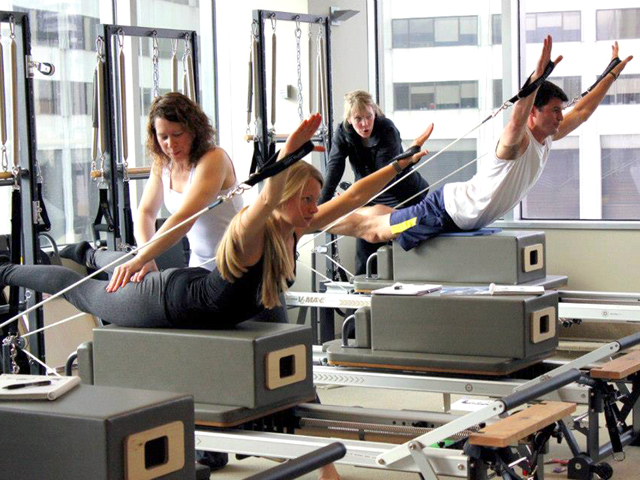This post is sponsored by Alsco Australia. Read more about their commitment to corporate environmental responsibility on their blog, Greenroom.

We know that a healthy workforce makes a healthy business. In fact, a study by Medibank, a health insurance company serving Australia and New Zealand, found that the healthiest employees are a staggering three times more productive than their unhealthy colleagues. (Health “scores” were measured against eight key areas: physical activity, nutrition, body weight, stress, risk behavior, sleep, pain, and medical health.) The same study also found that unhealthy employees take up to nine times more sick leave than their healthier colleagues.
Further, almost of half the employees studied were found to be not healthy, and another 25 percent were only marginally better. While this all sounds pretty grim, it presents a serious opportunity for business owners. Below, we’ve outlined the factors contributing to poor employee health, and shared our best tips for how you can start improving it in your workplace.
Factors contributing to your employees’ poor health
-
Lack of exercise
While Australia is famous for being a sport-loving country, the truth is that most Australians do not exercise enough to meet the minimum daily recommendation. Australia’s Physical Activity and Sedentary Behavior Guidelines recommend adults engage in at least 30 minutes of moderate to intense physical activity on most days. Regular exercise helps to ward off cardiovascular disease, type 2 diabetes, osteoporosis, and certain types of cancer, while helping the exerciser to develop stronger muscles, joints and bones, increase metabolism, reduce fatigue, and regulate stress.
-
Poor dietary habits
In today’s day and age of rush, food has become a chore rather than a life-giving, communal pleasure. Fresh foods have been replaced by processed foods, and sit down meals by on-the-go snacks. Everything around us is “instant”, and less than 10 percent of Australians eat the recommended five or more servings of fruit and vegetables per day.
-
Weight
Poor dietary habits combined with lack of exercise results in weight gain and obesity. Almost 60 percent of Australian workers are overweight. A global study of 9.1 million participants across 199 countries over nearly three decades found that obesity had doubled during this period. Of particular concern to us was that Australia was among the top three countries showing the greatest increase of obesity for both men and women. The adverse affects of obesity are daunting, especially in the workplace. From reduced productivity due to increased absenteeism to higher, obesity takes a toll.
-
Stress
Long work hours, uncertain employment conditions, interpersonal factors, and failure to achieve targets can cause stress at the workplace. Stress may also be caused outside the workplace. Whatever be the cause, chronic stress puts health at risk. Long-term activation of a body’s stress response mechanism, i.e. overexposure to hormones which the body releases to fight stress, can lead to various other diseases such as anxiety, depression, digestive problems, heart disease, sleep problems, weight gain, and memory impairment.
-
Indulging in medium to high-risk behavior
Behavior such as smoking, chronic drinking, and drugs are known causes of various health problems from stomach ailments to cancer.
-
Lack of adequate sleep
This leads to accidents on the road and on the job, causing injuries and losses. These people are also likely to take more sick leave than those who get a good night’s sleep.
-
Lack of adequate hygiene
Ick, right? But the reality is that, in the workplace, it can promote the spread of disease such as influenza and various others. It’s vital that proper hygiene and air quality is maintained in the workplace for optimum employee productivity.
Four things you can do to support your employees in improving their own health

With improved employee health resulting in direct a benefit for employers and employees alike, a workplace health program is a necessity. These programs and policies create a supportive culture and physical environment that encourages healthy lifestyles. Here are four steps you can take towards building your own:
1. Identify the areas you’ll focus on in your health program
Here are a few examples:
- Nutrition: Nutrition programs can help educate employees about food choices and equip them to make healthier ones. Organizations can ensure healthy foods are available in staff rooms, vending machines, or even at office functions. Consider bringing in a specialist such as a nutritionist to help everyone along.
- Physical activity: Workplace health programs can offer employees opportunities to incorporate physical activity into their daily lives as well as provide an environment — and to the extent possible, infrastructure — that supports physical activity and exercise (i.e., a fitness center, bicycle racks, etc.). Again, consider a specialist, in this case, a fitness instructor.
- Improving hygiene: Adopting quality hand hygiene products such as those supplied by a professional, premier washroom rental partner like Fresh & Clean (an Alsco company) and educating employees on their proper use could be the difference between a healthy workplace and an unhealthy one.
2. Set clear goals for each area of focus
Your workplace health program should have clear goals with SMART (specific, measurable, achievable, relevant, time-bound) objectives. If the goal of your program is to provide access to healthier food options, an objective could be to replace 50 percent of all food provided within the organization with healthier options. An action plan to achieve this objective would include tasks such as liaising with local vendors to provide boxes of salads, fresh fruits, and whole grain instead of regular bread in sandwiches.
3. Promote the program to raise awareness
Implement steps one and two while promoting the program. It is important to raise awareness and generate interest in participating. Maybe now is the time to bring in a specialist for a lunch-and-learn or fitness demonstration. Regular motivation alongside rewards and incentives for employees are important aspects to any program like this.
4. Evaluate and improve
Finally, it is important to evaluate the program based on the objectives set out in the beginning. Learning best practices, ideas, and tips via blogs like Greenroom, and adopting them will help you continue to build an excellent health and wellness program.
Good luck!


